‘Charity begins at Home’ The United States government & Irish Famine relief 1845-1849
Published in 18th–19th - Century History, Features, Issue 2 (Summer 1996), The Famine, Volume 4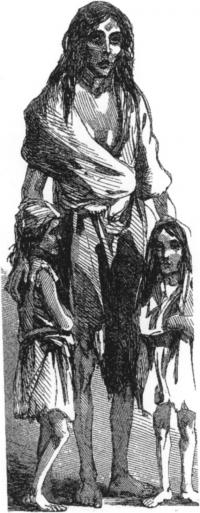 ‘No imagination can conceive —no tongue express—no brush paint—the horrors of the scenes which are daily exhibited in Ireland’, observed Senator Henry Clay in 1847. Calling upon the support of his Creator, he reminded his fellow Americans that ‘the practice of charity’ was the greatest act of humanity. In terms of private efforts, Americans heard Clay’s clarion call for relief.
‘No imagination can conceive —no tongue express—no brush paint—the horrors of the scenes which are daily exhibited in Ireland’, observed Senator Henry Clay in 1847. Calling upon the support of his Creator, he reminded his fellow Americans that ‘the practice of charity’ was the greatest act of humanity. In terms of private efforts, Americans heard Clay’s clarion call for relief.
Since a large amount of American relief passed through the Society of Friends in Dublin, a record has been preserved in its published report entitled, Transactions of the Society of Friends during the Famine in Ireland. The report stated that ‘The munificent bounty of the citizens of the United States was on a scale unparalleled in history’. It showed that 118 vessels sailed to Ireland with US relief goods. The value of these shipments amounted to $545,145. The report did not include other relief donations of friends and relatives that passed directly to the victims. With this additional assistance, it has been estimated that the United States raised millions of dollars for Ireland. One hundred and fifty years later most Irish and Irish American historians are aware of this private generosity during the famine years, but they are less familiar with the role of the United States government.
Famine as economic opportunity
American officials in London and Ireland reported on the bleak conditions of Ireland to President James Polk and his Secretary of State, James Buchanan. These horrific descriptions, however, seemed to serve as the pretext or rationale for what became their primary observation and concern about the potato blight in Ireland—increased demand for American food. George Bancroft, the father of American history with his ten-volume work, History of the United States from the Discovery of the Continent, was US minister in London between 1846 and 1849. In his first dispatch to Washington DC, dated 3 November 1846, he enthusiastically noted that there was a conspicuous increase in the British demand for American Indian corn and that members of parliament repeatedly asked him for the potential supply of Indian corn from that country. He attributed this sudden British demand for Indian corn to the repeal of the corn laws, but more significantly, he pointed to ‘the scarcity in Ireland and England consequent on the failure of the potato crop’. He predicted that for at least two more years Britain ‘will be dependent on American exports’. He saw this ‘future want’ extending beyond corn to include ‘meat, wheat and pork’. Again he stated the reason: Britain was a large consumer of American goods due to ‘the appalling distress occasioned by the famine in Ireland’. In fact, Bancroft opined, Britain now needed the United States more than she needed her, and as a result, the United States was approaching equality and possibly surpassing Britain in ‘commerce, manufacturing skill, and wealth’. He concluded ‘that everybody perceives the benefits that will come to our country [due to the famine] which is becoming the most opulent in the world’.
American Indian corn to replace the Irish potato
The American consular officer in Dublin, Thomas Wilson, concurred with Bancroft’s propitious forecast in his reports to President Polk. Because of the famine and because of the devastation of the potato crop, Wilson advised the President:
It [the potato] will have to be replaced or supplied with that which can be procured in the cheapest of terms. It is, therefore, highly probable that Indian corn from the United States will have to be imported in very large quantities.
The Belfast Consul, Thomas Griffin, confidently deduced from his vantage point that within the next few years Famine Ireland would double its imports of American goods. He also believed that the beleaguered conditions in Ireland presented the United States with a great financial opportunity, which could permanently accrue to the benefit of American trade with Ireland. If American goods continued to flow in at this high a rate, he was convinced that Irish dependency on the potato could be replaced by Irish dependency on American Indian corn:
Because of the difficulties of procuring seed and the want of confidence in the potatoes as a crop in this country—certainly for this year—and probably through 1848 and 1849, Indian corn will be generally substituted and from the large supplies at a cheap rate which we may anticipate from the United States during the above period so far should establish itself as the common diet of the country.
Irish relief legislation in Congress
Ironically, while these official reports proffered American economic gain and Irish economic dependency as a result of the Famine, the US Congress was considering and debating legislation that would provide federal relief for the suffering in Ireland. On 8 February 1847, Congressman Washington Hunt of New York introduced an Irish relief measure to his legislative colleagues. The bill requested that the United States government spend $500,000 to purchase articles of subsistence for Ireland and to provide the necessary transport. The bill was read twice and then sent to a special committee. While the bill resided in the committee, Congressman Charles Ingersoll of Pennsylvania voiced his concern for Ireland. He demanded relief legislation, saying that the Irish played a vital part in US history and that, out of all the countries of the world, the United States could best afford to send financial relief. Despite these efforts of Hunt and Ingersoll, the relief bill never re-emerged on the House floor and died in committee.
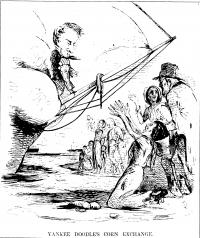
Yankee Doodle’s Corn Exchange(Yankee Doodle)
This American cartoon praises that country’s ability to feed Ireland from it’s surplus grain;but it is unclear just how the destitute were expected to purchase such supplies.
Arguments for
Aware of the abortive attempt in the House, Senator John J. Crittenden of Kentucky proposed the same bill in the Senate on 26 February 1847. He defended his piece of legislation by pointing to a precedent in American history to prove the bill’s constitutionality. In 1812, President James Madison appropriated £50,000, approved by both Houses of Congress, to purchase and to send assistance to Caracas, Venezuela, a city that had just been stricken by a sizeable earthquake. Senator Crittenden insisted that Venezuela only represented a ‘partial calamity’ while Ireland’s affliction was a ‘national’ one, and yet America had not helped Ireland. He maintained that even without the historical precedent, the US constitution did not prohibit charity. He made a final moral appeal to his fellow members:
Can you imagine any moral spectacle more sublime than that of one nation holding out that hand which is full of plenty to the suffering people of another country?
After Senator Crittenden took his seat, Senator Thomas Clayton of Delaware expressed his support for Crittenden’s bill. He moved that it be read three times and passed immediately, indicating that he spoke with the authorisation of his state’s legislature and people. They mandated him in a resolution to encourage and approve any government measure that would provide relief for Ireland. The motivation for such a request appeared in the preamble of the resolution: ‘Christian people blessed with agricultural abundance should provide for those perishing with hunger and want’. Senator Lewis Cass of Michigan also endorsed the bill, arguing that the ‘angel of death’ was mercilessly killing the people of Ireland and that the magnitude of this adversity demanded federal relief legislation.
Arguments against
The debate continued through the next day with Senator John Niles of Connecticut leading the opposition. He began his harangue by asking whether the Irish famine was a national concern of the US government. He, of course, responded negatively to his own question and elaborated. The Irish famine was the responsibility of the English government and should not concern the government of the United States. To send relief would make England look weak in the eyes of the world community; thus such action would be ‘disrespectful’. If funds were sent to Ireland, he inquired, why not send funds to Scotland, France, and Prussia. Proclaiming ‘charity begins at home’, Niles rhetorically rejoined why do we send money to assist foreign peoples, when some of our own citizens could use it. Finally, he concluded by declaring that the bill was unconstitutional because it used public monies not in the nation’s interest. Such action by Congress could only lead to a tradition promoting ‘a dangerous exercise of power’.
Despite the opposition and abstentions, the Crittenden bill passed, and then made its way to the floor of the House of Representatives for its approval. On 1 March, Congressman Hunt requested that the bill be considered by fellow members. Lewis Levin, representative of Pennsylvania and a leader of the House opposition, proposed that the bill be sent to the Ways and Means Committee. Perceiving the politics of the legislation’s appeal to Irish-American voters, Levin portrayed the bill as legislation ‘disguised to afford food for party vultures, rather than bread for the starving people’. He then repeated the same opposition arguments given previously in the Senate.
Opposition to the bill was also influenced by the political climate of the period which was primarily driven by the arrival of millions of German and Irish immigrants. Fear that foreigners and Catholics might destroy American freedom and culture led to the emergence of a nativist movement. In New York City the American Republican Party was founded in 1843 on the back of hostility to foreigners and Catholics. Lewis Levin, one of the party’s leaders, became the primary champion of nativistic legislation in the pre-Civil War years. Even before the Irish relief bill, he presented a piece of legislation that would prohibit immigrants from becoming American citizens by extending the requirement of naturalisation from days to twenty-one years. This debate occurred in the House between 17-30 December 1845. But the nativist voices of intolerance and anti-Catholicism did not win the day over the immigrant vote for its election victories. Not surprisingly, after the Levin’s resolution was killed, ‘nativism as a legislative issue was dead’ until the rise of Know-Nothingism in the 1850s. Consequently, it was not the ugly head of bigotry but constitutional limitations and laissez-faire economics that killed the Irish relief bill.
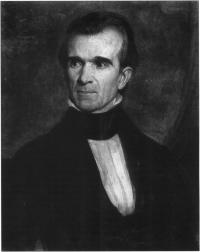
US President James Polk (Tennessee Historical Society)
President Polk’s veto threat
The Crittenden bill remained in the committee until the end of the session. Throughout these three days, Congressmen Robert C. Winthrop of Massachusetts and John Wentworth of Illinois incessantly asked for consideration of the bill, but their numerous requests were denied. Towards the end of the session, Wentworth made a last futile appeal yet that day the bill met its demise in committee. Winthrop, during one of his appeals, presented what was probably the major reason for the bill being held hostage in the House. As a member of the Ways and Means Committee, Winthrop thought that a general ‘understanding’ existed among its members—that if the bill passed, President Polk would veto it.
At first glance it would appear that President Polk should have supported the bill. His family was of Scotch Irish descent, and he was the presidential candidate of the Democratic Party, who had barely beaten the Whig candidate, Henry Clay, in 1844. Polk realised that his winning of the crucial popular and electoral votes of New York was largely due to Democratic Party officials naturalising sixty Irish immigrants daily weeks before the election. These naturalised Irish immigrants cast the essential votes on election day that won it for Polk and his party.
So Polk’s natural inclination and political motivation would be to support such an Irish relief bill. Yet his diary during these crucial days for the Crittenden bill provide the rationale for a diametrically opposite position. In a cabinet meeting on 2 March, Polk said that he was aware of the passage of the bill in the Senate a few days before and of its consideration at present in the House. He announced to his cabinet that if the bill passed in the House, he would have no alternative but to veto it. He then gave his justification for such action: ‘the chief of which was the want of constitutional power to appropriate money of the public to charities either at home or abroad’. After the cabinet meeting, Polk made the following entry in his journal:
I informed them that if the bill received the sanction of the House of Representatives I would be compelled to put my veto upon it. I have all the sympathy for the oppressed Irish and Scotch. A few days ago I contributed $50 for their relief but my solemn conviction is that Congress possesses no power to use public money for any such purpose.
The next day, 3 March, President Polk discussed the situation with Secretary of State James Buchanan. During the course of their conversation, Polk reiterated his basic argument, calling the relief bill ‘unconstitutional’. He informed Buchanan that he had written a veto message just in case the bill passed. By the end of the day, Polk received news of the bill’s defeat in the House, and summarily discarded his veto message. In all of his notes and messages concerning Irish relief that followed his threatened veto, Polk, concerned about the negative political impact upon Irish voters, was careful to express his sympathy for the suffering in Ireland. He was also diligent when explaining his opposition to the relief bill that it was based upon the constitutional limits of federal power and his belief in laissez-faire economics, gladly making references to his earlier reduction of trade barriers in the Walker tariff of 1846 and to his ultimate goal of free trade.
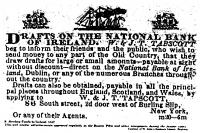
1847 cash draft issued in New York to be drawn on the National Bank of Ireland- over the course of the famine hundreds of thousands of dollars were sent from America to Ireland by the Irish immigrants.
The Macedonian and the Jamestown
Although Congress and the President prevented the passage of a government relief bill, they did approve and pass a piece of legislation that allowed the use of two public vessels to ship relief goods to Ireland. In February 1847, Senator John Fairfield proposed a joint resolution that sought the service of two dishevelled warships, the Macedonian and the Jamestown, and two experienced sea captains, Robert Forbes of Boston and George DeKay of New Jersey. Because he was opposed to monetary relief, Senator Fairfield made a distinction between his and Crittenden’s bill. He maintained that contrary to direct financial relief by the government, his bill did not propose a transfer of property or passing of title. It only represented ‘the use’ of government property. Further, the constitution did not regulate the navy as it did the expenditure of public funds. In the end, the bill passed through the Senate on 2 March 1847 and the House on 3 March.
The story of the voyages of these two ships was told by Captain Forbes in his Personal Reminisces. The Jamestown was a triumph. It was recommissioned at Charelstown and placed in the custody of the Boston Committee for Irish Relief and under the command of Forbes who was renowned and respected for his expertise as a seaman. Familar with commerce and trade on the seas, Forbes immediately acquired the firms of N. and I. Cummins and James Scott & Co. to act as agents at Cork and Cove. The Boston relief committee spent one month collecting donations for the voyage. By the time of loading on St Patrick’s Day 1847, the committee had 800 tons of foodstuffs to be loaded onto the Jamestown. For the most part the shipment was comprised of Indian corn and bread but it also included potatoes, flour, rye, beans, rice, oatmeal, ham and pork, and sixteen barrels of clothing. Also placed on board were letters of introduction to the bishop of Cork and Father Theobald Mathew.
The Jamestown set sail on 28 March and, in spite of rough seas and inclement weather, it made the voyage in fifteen days, docking in Cork on 12 April. Citizens of Cork greeted the Jamestown and its crew with great fanfare. Cheering men, women and children went down to the quay, the city bells ran, and for the ten days the crew remained in Cork they were treated as honoured guests.
Besides attending receptions, Forbes and his crew members, and Cork officials unloaded and distributed the relief goods. They established a distribution committee that purveyed the food throughout Cork and its 160 districts. The committee also filled special and personal requests for aid from some of the most devastated areas, such as Skibbereen, Cove, and Kinsale. Father Mathew also took Forbes on a personal tour of the impoverished and desperate areas in Cork. Forbes, greatly overcome by the suffering he saw in the streets of Cork, made the following observation: ‘I would gladly forget, if I could, the scenes I witnessed…in two hours walk, I saw more actual distress and apparent poverty than I ever saw in my whole life…’
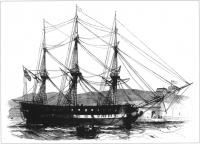
The USS Macedonian, the second of two American warships which brought food aid to Ireland in 1847.
(Illustrated London News)
On 22 April the Jamestown departed Cork and arrived in the United States twenty-four days later. While the Jamestown had completed its journey, the Macedonian remaineddocked in New York harbour only partially loaded. The overwhelming support for the Jamestown in Boston was not matched for the Macedonian in New York. The citizens of New York had several concerns about this relief venture. Some incorrectly thought that this ship was a former British warship captured in the war of 1812, while others complained about the ship being placed under the command of a former naval officer. Although these concerns deterred some from contributing to the cause, the real reason was that New York was a centre of nativism and the American Republican Party. The nativist attack on Catholics and foreigners severely proscribed the collection of goods by DeKay.
With such opposition, DeKay sought out Forbes for help when he returned from Ireland on the Jamestown. Forbes and the Boston committee came to DeKay’s rescue. They collected foodstuffs and brought them to New York City. On 19 June, thanks primarily to the Boston committee’s efforts, the Macedonian set sail with a full cargo for Ireland and landed in Cork on 14 July. After receiving a warm welcome, DeKay dispersed the goods through the Society of Friends distribution points. This was the case for all the supplies except for one personal request that was delivered to none other than Maria Edgeworth on her estate at Edgeworthstown. All told, she was given fifty barrels of foodstuffs to help her feed her destitute tenants.
By August, the Macedonian had returned to New York. While she experienced many more difficulties in preparation of the voyage than the Jamestown, it too finally succeeded in sending relief to Ireland. But the Macedonian did exact a much heavier price for its success in the long run. DeKay had to spend $30,000 of his own money to purchase additional supplies as well as to hire a crew. Because this placed him in a very precarious position financially, he requested some financial relief from Congress. Before a response came back from Washington DC, DeKay died exhausted and near penniless because of his efforts to help the suffering in Ireland.
Conclusion
In glaring contrast to these admirable and privately-run relief efforts, it appeared that the American government failed the starving Irish. Instead of $500,000, the Polk administration and Congress contributed two war-worn vessels. Economic opportunism and a laissez-faire interpretation of the constitution were the key components in shaping the American government’s official response to the famine in Ireland. The magnanimous call for charity and the cries of Irish suffering, although heard by American officials, did not take precedence over national interest. In her recently published article, ‘The operations of famine relief, 1845-1847’, Mary Daly concluded: ‘One could have done more to save lives…but responsibility does not lie solely with the [British] government’. She then stated that suffering could have been mitigated, if landlords, land agents, the Catholic clergy, and politicians like Daniel O’Connell and the Young Irelands, had done more. The American government must be added to this list of culpability. Perhaps a little more humanity and less self interest could have helped to alleviate the scope of human suffering.
Timothy J. Sarbaugh is Associate Professor of History at Gonzaga University, Washington.
Further reading:
T.J. Sarbaugh (ed.), North America and the Irish Famine (Connecticut 1996).
C. Woodham-Smith, The Great Hunger (London 1962).
C. Ó Gráda, The Great Irish Famine (London 1989).
K. Miller, Emigrants and Exiles (Oxford 1985).
















